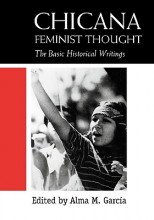 Reading Assignment: Your reply (under Comments) due before class on Wednesday, January 18. Remember, you don’t need to answer all or even any of the questions, but your response should demonstrate you’ve done and thought about the readings.
Reading Assignment: Your reply (under Comments) due before class on Wednesday, January 18. Remember, you don’t need to answer all or even any of the questions, but your response should demonstrate you’ve done and thought about the readings.
o0o
Tessie Liu “Teaching the Differences Among Women from a Historical Perspective: Rethinking Race and Gender as Social Categories” (from Unequal Sisters 29-40),
Readings for Alma Garcia, Chicana Feminist Thought
- ”A Chicana Message” (35)
- “Empieza La Revolution Verdadera” (73)
- “Para Un Revolucionario” (74-75)
- “Viva La Chicana and All Brave Women of La Causa” (80-81)
- “El Movimiento and the Chicana” (81-82)
Are the “Anonymous” articles different from the signed ones? What power does it invest or take away from someone to sign an article “A Chicana” or “Anonymous” rather than with their name? Why do you think these articles were unsigned? Do you agree with the authors ideas about gender, sex and competition?
In reading Tessie Liu’s section of Unequal Sisters, “Teaching the Differences Among Women from a Historical Perspective,” she opens by stating “we must recognize that race is a gendered category.” Are you convinced? Do you see race gendered as gendered, and if so, how? In what ways do you think the term “Latina/o” or “Chicana/o” are racial? In what ways are they not? How does race complicate ethnicity?
Using all the readings, what do you see as problems circa 1960s and 1970s (and now too) with the idea of universal sisterhood between all women? In what ways is it similar (and / or in conflict) with ideas of nationalism? Especially for those of you that see yourselves as teachers (or future teachers at least), do you think Liu is right in saying that white is the universal normal, is the default? How do Latinas fit into that paradigm? When do you feel like an insider in terms of race and / or gender? When like an outsider?
Reading the poems by Lorna Dee Cervantes and Anne NietoGomez, how and why do the authors deploy English and Spanish? Is the discussion of union between men and women in NietoGomez sexualized? If so, how? How about in Cervantes?
Which of readings seems most relevant to you now and why? Which seem dated or outside your experience?
—–
The video I mentioned in class Black & Latino. Please watch it when you get a chance. It’s about 10 minutes long.